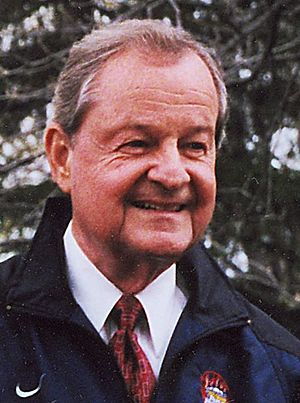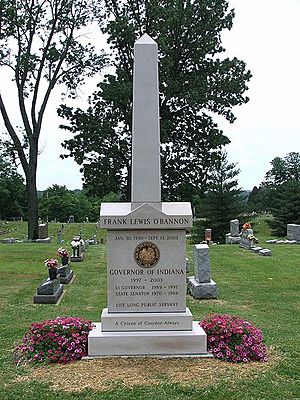Frank O'Bannon facts for kids
Quick facts for kids
Frank O'Bannon
|
|
|---|---|

O’Bannon in 1999
|
|
| 47th Governor of Indiana | |
| In office January 13, 1997 – September 13, 2003 |
|
| Lieutenant | Joe Kernan |
| Preceded by | Evan Bayh |
| Succeeded by | Joe Kernan |
| 46th Lieutenant Governor of Indiana | |
| In office January 9, 1989 – January 13, 1997 |
|
| Governor | Evan Bayh |
| Preceded by | John Mutz |
| Succeeded by | Joe Kernan |
| Member of the Indiana Senate | |
| In office November 4, 1970 – December 1, 1988 |
|
| Preceded by | Robert O'Bannon |
| Succeeded by | Richard D. Young |
| Constituency | 29th district (1970–1972) 46th district (1972–1982) 47th district (1982–1988) |
| Succeeded by | Leslie Duvall |
| Personal details | |
| Born |
Frank Lewis O'Bannon
January 30, 1930 Louisville, Kentucky, U.S. |
| Died | September 13, 2003 (aged 73) Chicago, Illinois, U.S. |
| Political party | Democratic |
| Spouse | Judy Asmus (1957–2003; his death) |
| Education | Indiana University, Bloomington (BA, JD) |
| Military service | |
| Allegiance | |
| Branch/service | |
| Years of service | 1952–1954 |
| Battles/wars | Korean War |
Frank Lewis O'Bannon (January 30, 1930 – September 13, 2003) was an American politician. He served as the 47th governor of Indiana from 1997 until he passed away in 2003. He is the most recent U.S. Governor to die while still in office.
O'Bannon grew up in Corydon, Indiana. He graduated from Corydon High School in 1948. He then attended Indiana University, where he met his wife, Judy. Before becoming a politician, he worked as a lawyer and published a newspaper called The Corydon Democrat.
O'Bannon was a conservative Democrat. He was first elected to the Indiana Senate in 1969. He became a very important member of the Senate. In 1988, he planned to run for Governor of Indiana. However, he decided to join Evan Bayh as his running mate instead. The team of Bayh and O'Bannon won, and O'Bannon served as lieutenant governor for eight years. In this role, he led the State Senate and managed the state's agriculture and business programs.
Contents
Becoming Governor
In 1996, Governor Evan Bayh could not run for a third term. So, Frank O'Bannon ran for governor. Many people thought he would lose, but he won a close election against Indianapolis Mayor Stephen Goldsmith. He was re-elected in 2000, beating Congressman David M. McIntosh.
As governor, O'Bannon was known for supporting education. He also helped create the state's AMBER Alert System. This system helps find missing children quickly. During the 1990s, Indiana's economy was doing very well. O'Bannon also served as the leader of the Midwestern Governors Association. He passed away while in office in 2003. His lieutenant governor, Joe E. Kernan, became the new governor.
Early Life and Education
Frank O'Bannon was born in Louisville, Kentucky. He grew up in Corydon, Indiana, which was once the first capital of Indiana. His family owned the local newspaper, The Corydon Democrat. His father, Robert Presley O'Bannon, was also a politician who served in the Indiana House and Senate.
Frank O'Bannon attended Indiana University. He played basketball for one season there. He earned a bachelor's degree in government in 1952. He then earned a law degree from the Indiana University Maurer School of Law in 1957.
He also served for two years in the United States Air Force. While at Indiana University, he met his wife, Judith Asmus. They got married in 1957. After law school, he opened his own law office in Corydon. He also led his family's newspaper business and was on the board of a local bank.
Political Journey
Serving in the Indiana Senate
Frank O'Bannon was first elected to the state senate in 1969. He took over the seat his father had held for many years. In the Senate, he supported a law that brought back the death penalty in Indiana. He became the leader of the Democratic members in the Senate. He also led the Senate Finance Committee for a short time when Democrats were the majority.
Becoming Lieutenant Governor
In 1987, O'Bannon announced he would run for governor. He was going to run against Evan Bayh. But in 1988, O'Bannon decided to stop his own campaign. Instead, he joined Evan Bayh as his running mate for lieutenant governor. They won the election in November 1988. As lieutenant governor, O'Bannon was the president of the State Senate. He also directed the state's business and agriculture programs.
Leading as Governor
In 1996, O'Bannon became the Democratic candidate for governor. He won the election against Indianapolis mayor Stephen Goldsmith. It was a close race, with O'Bannon getting 52% of the votes. He was re-elected in 2000 by a larger margin, with 57% of the votes. He won against Congressman David M. McIntosh.
During the good economic times of the 1990s, Indiana had a lot of extra money. Governor O'Bannon was able to cut taxes. He also hired 500 more police officers and increased money for schools. He helped more poor families get health insurance. He signed important laws, like the one creating the AMBER Alert program in Indiana. He also signed a law requiring drivers to slow down or move over for emergency vehicles.
In 1998 and 1999, O'Bannon was the Chairman of the Midwestern Governors Association. In 1999, he created the Public Access Counselor Office. This office helps people get government information in Indiana.
In 2000, he easily won his re-election campaign. His campaign slogan was "Keeping Indiana Moving in the Right Direction." His TV ads even showed him making a perfect basketball shot, reminding people of his past.
After the 9/11 and a drop in the economy, Indiana lost many jobs. Tax money decreased. O'Bannon had to cut some social services. But he tried to protect funding for education. In 2001, he worked with the state legislature to change the state's tax system.
O'Bannon was known as a strong leader for education in Indiana. He helped create Indiana's first community college system. He also pushed for early learning programs for young children. He supported new types of high schools and charter schools. His work helped Indiana's schools meet the standards of the federal No Child Left Behind Act. He focused on making public schools better and increased their funding.
Passing and Legacy
Frank O'Bannon had a serious stroke on September 8, 2003. He was in Chicago for a trade conference. He was taken to the hospital and remained unconscious. His health got worse. Based on his wishes, his family decided to stop medical support. He passed away on September 13, 2003, at age 73. He left behind his wife, Judy, three children, and five grandchildren.
O'Bannon was an organ donor. He had signed laws to make organ donation easier in Indiana. His cornea helped an Illinois woman regain her sight. His ashes were spread in his family's burial plot in Corydon, Indiana.
After O'Bannon's death, Lieutenant Governor Joe E. Kernan became the new governor. He was sworn into office just hours later.
In 2006, a book called Legacy of a Governor: The Life of Indiana's Frank O'Bannon was written about him. Also in 2006, a memorial bust (a sculpture of his head and shoulders) was placed outside the Indiana Statehouse Senate chambers.
Judy O'Bannon continued to live in Corydon, Indiana. She remained active in politics and with her husband's newspaper. She also hosted a public television show.
See also


